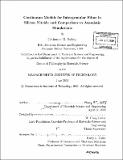Continuum models for intergranular films in silicon nitride and comparison to atomistic simulations
Author(s)
Bishop, Catherine M. (Catherine Mary), 1975-
DownloadFull printable version (9.482Mb)
Other Contributors
Massachusetts Institute of Technology. Dept. of Materials Science and Engineering.
Advisor
W. Craig Carter.
Terms of use
Metadata
Show full item recordAbstract
A continuum thermodynamic model is developed for the treatment of interfaces in materials. This phase-field model includes energetic contributions from chemical, structural and electrostatic effects. A small parameter set is introduced in the model. These parameters should be adjusted based on the relation of equilibrated phase-field structures to atomistic simulations and experimental observations. To compare the continuum fields to discrete data sets, coarse-graining methods are proposed. Two methods of measuring local atomic structure are developed, one based on Voronoi tessellations and the other based on bond-angle distribution functions. A coarse-graining method based on volume averaging over Voronoi tessellations is employed to continuize both structure and composition information. These fields give insight into the local atomic environment that is necessary for devising continuum models. The stability of intergranular films in CaO-doped Si₃N₄ is examined. A modified associate model that incorporates bulk-thermodynamic Gibbs free energy functions and treats non-bulk equilibrium compositions is developed. Kinetic equations are derived to solve for the equilibrium fields. While the simulations do not reach equilibrium, some trends can be observed. Locally charged domains are kinetically stable near the film. Non-uniform calcium distributions in the doped films indicate that calcium is preferentially located near the film-grain interface. The structural width of the film can be tuned by altering appropriate model parameters. (cont.) Future avenues of research suggested by this thesis include: developing algorithms for measuring local structure and orientation in multi-component systems and devising atomistic simulations of intergranular pockets that couple experimental information with interatomic potentials.
Description
Thesis (Ph. D.)--Massachusetts Institute of Technology, Dept. of Materials Science and Engineering, 2003. Includes bibliographical references (leaves 145-155).
Date issued
2003Department
Massachusetts Institute of Technology. Department of Materials Science and EngineeringPublisher
Massachusetts Institute of Technology
Keywords
Materials Science and Engineering.